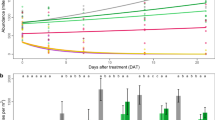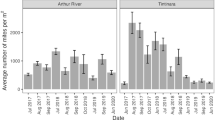Abstract
The redlegged earth mite (Halotydeus destructor) is an important agricultural pest in Australia, with a wide range of plant hosts. Halotydeus destructor has developed resistance to pyrethroid and organophosphorus insecticides as a consequence of the widespread use of these chemicals by farmers. Neonicotinoids are one of the few remaining insecticide classes registered against H. destructor in which resistance has not been detected, although there have been occasional reports of control difficulties experienced in the field. There is currently no reliable way to accurately test the response of H. destructor (or indeed any mite species) to neonicotinoid insecticides. Here, we developed a new bioassay to assess the response of mites against the neonicotinoid imidacloprid. The method provided consistent results and showed no variation when used by different operators. We generated base-line sensitivity data for imidacloprid across a number of field-collected populations of H. destructor. This is important for future monitoring of mite responses given the considerable selection pressure now being exerted across large areas of the Australian farming landscape through the widespread use of neonicotinoid seed treatments.


Similar content being viewed by others
References
APRD (2019) Arthropod Pesticide Resistance Database. https://www.pesticideresistance.org/. Accessed 18 April 2019
APVMA (2019) Public Chemical Registration Information System Search. https://portal.apvma.gov.au/pubcris. Accessed 20 May 2019
Ay R (2005) Determination of susceptibility and resistance of some greenhouse populations of Tetranychus urticae Koch to chlorpyrifos (Dursban 4) by the petri dish-potter tower method. J Pest Sci 78:139–143
Barati R, Hejazi MJ (2015) Reproductive parameters of Tetranychus urticae (Acari: Tetranychidae) affected by neonicotinoid insecticides. Exp Appl Acarol 66:481–489
Chagnon M, Kreutzweiser D, Mitchell EAD et al (2015) Risks of large-scale use of systemic insecticides to ecosystem functioning and services. Environ Sci Pollut Res 22:119–134
Chen Y, Dai G (2015) Acaricidal activity of compounds from Cinnamomum camphora (L.) Presl against the carmine spider mite, Tetranychus cinnabarinus. Pest Manag Sci 71:1561–1571
de Little SC, Edwards O, van Rooyen AR et al (2017) Discovery of metabolic resistance to neonicotinoids in green peach aphids (Myzus persicae) in Australia. Pest Manag Sci 73:1611–1617
Dennehy TJ, Farnham AW, Denholm I (1993) The microimmersion bioassay: a novel method for the topical application of pesticides to spider mites. Pestic Sci 39:47–54
Dermauw W, Ilias A, Riga M et al (2012) The cys-loop ligand-gated ion channel gene family of Tetranychus urticae: implications for acaricide toxicology and a novel mutation associated with abamectin resistance. Insect Biochem Mol Biol 42:455–465
Douglas MR, Rohr JR, Tooker JF (2015) Neonicotinoid insecticide travels through a soil food chain, disrupting biological control of non-target pests and decreasing soya bean yield. J Appl Ecol 52:250–260
Edwards OR, Walsh TK, Metcalfe S et al (2018) A genomic approach to identify and monitor a novel pyrethroid resistance mutation in the redlegged earth mite, Halotydeus destructor. Pestic Biochem Physiol 144:83–90
Elbert A, Becker B, Hartwig J, Erdelen C (1991) Imidacloprid—a new systemic insecticide. Pflanzenschutz-Nachr Bayer 44:113–136
European Union (2018) Commission Implementing Regulation (EU) 2018/783 of 29 May 2018 amending Implementing Regulation (EU) No 540/2011 as regards the conditions of approval of the active substance imidacloprid. https://eur-lex.europa.eu/legal-content/EN/TXT/?uri=uriserv:OJ.L_.2018.132.01.0031.01.ENG&toc=OJ:L:2018:132:TOC. Accessed 12 Jun 2019
Foster SP, Denholm I, Thompson R (2003) Variation in response to neonicotinoid insecticides in peach-potato aphids, Myzus persicae (Hemiptera: Aphididae). Pest Man Sci 59:166–173
Gaull KR, Ridsdill-Smith TJ (1996) The foraging behaviour of redlegged earth mite, Halotydeus destructor (Acarina: Penthaleidae), in an annual subterranean clover pasture. Bull Entomol Res 86:247–252
Hoffmann AA, Porter S, Kovacs I (1997) The response of the major crop and pasture pest, the redlegged earth mite (Halotydeus destructor) to pesticides: dose-response curves and evidence for tolerance. Exp Appl Acarol 21:151–162
Hsu J (1996) Multiple comparisons. Chapman and Hall, New York
IRAC (2019) Insecticide Resistance Action Committee (IRAC) test methods. https://www.irac-online.org/methods/. Accessed 18 Jun 2019
James DG, Price TS (2002) Fecundity in twospotted spider mite (Acari: Tetranychidae) is increased by direct and systemic exposure to imidacloprid. J Econ Entomol 95(4):729–732
Jenkins S, Hoffmann A, Mccoll S et al (2013) Synthetic pesticides in agro-ecosystems: are they as detrimental to nontarget invertebrate fauna as we suspect? J Econ Entomol 106:756–775
Jeschke P, Nauen R, Schindler M, Elbert A (2011) Overview of the status and global strategy for neonicotinoids. J Agric Food Chem 59:2897–2908
Kabir KH, Chapman RB, Penman DR (1993) Miticide bioassays with spider mites (Acari: Tetranychidae): effect of test method, exposure period and mortality criterion on the precision of response estimates. Exp Appl Acarol 17:695–708
Maclennan KE, McDonald G, Ward SA (1998) Soil microflora as hosts of redlegged earth mite (Halotydeus destructor). Entomol Exp Appl 86:319–323
Maino JL, Binns M, Umina P (2018) No longer a west-side story—pesticide resistance discovered in the eastern range of a major Australian crop pest, Halotydeus destructor (Acari: Penthaleidae). Crop Pasture Sci 69:216–221
R Core Team (2018) R: a language and environment for statistical computing. R Foundation for Statistical Computing, Vienna
Ridsdill-Smith TJ (1997) Biology and control of Halotydeus destructor (Tucker) (Acarina: Penthaleidae): a review. Exp Appl Acarol 21:195–224
Ridsdill-Smith TJ, Hoffmann AA, Mangano GP et al (2008) Strategies for control of the redlegged earth mite in Australia. Aust J Exp Agric 48:1506–1513
Robertson JL, Preisler J (1992) Pesticide bioassays with arthropods. CRC Press, Boca Raton
Sanchez-Bayo F (2014) The trouble with neonicotinoids. Science 346:806–807
Shimomura M, Yokota M, Matsuda K et al (2004) Roles of loop C and the loop B–C interval of the nicotinic receptor a subunit in its selective interactions with imidacloprid in insects. Neurosci Lett 363:195–198
Smith JF, Catchot AL, Musser FR, Gore J (2013) Effects of aldicarb and neonicotinoid seed treatments on twospotted spider mite on cotton. J Econ Entomol 106:807–815
Solomon ME (1937) Experiments on the effects of temperature and humidity on the survival of Halotydeus destructor (Tucker), Acarina fam. Penthaleidae. Aust J Exp Biol Med Sci 15:1–16
Sparks TC, Nauen R (2015) IRAC: mode of action classification and insecticide resistance management. Pestic Biochem Physiol 121:122–128
Stapel JO, Cortesero AM, Lewis WJ (2000) Disruptive sublethal effects of insecticides on biological control: altered foraging ability and life span of a parasitoid after feeding on extrafloral nectar of cotton treated with systemic insecticides. Biol Control 17:243–249
Szczepaniec A, Creary SF, Laskowski KL et al (2011) Neonicotinoid insecticide imidacloprid causes outbreaks of spider mites on elm trees in urban landscapes. PLoS ONE 6:e20018
Thind BB, Muggleton J (1998) A new bioassay method for the detection of resistance to pesticides in the stored product mite Acarus siro (Acari: Acaridae). Exp Appl Acarol 22:543–552
Umina PA (2007) Pyrethroid resistance discovered in a major agricultural pest in southern Australia: the redlegged earth mite (Acari: Penthaleidae). Pest Manag Sci 63:1185–1190
Umina PA, Arthur AL, McColl SA et al (2010) Selective control of mite and collembolan pests of pastures and grain crops in Australia. Crop Prot 29:190–196
Umina PA, Edwards O, Carson P et al (2014) High levels of resistance to carbamate and pyrethroid chemicals widespread in Australian Myzus persicae (Hemiptera: Aphididae) populations. J Econ Entomol 107:1626–1638
Umina PA, Hoffmann AA (1999) Tolerance of cryptic species of blue oat mites (Penthaleus spp.) and the redlegged earth mite (Halotydeus destructor) to pesticides. Aust J Exp Agric 39:621–628
Umina PA, Hoffmann AA, Weeks AR (2004) Biology, ecology and control of the Penthaleus species complex (Acari: Penthaleidae). Exp Appl Acarol 34:211–237
Umina PA, Jenkins S, McColl S et al (2015) A framework for identifying selective chemical applications for IPM in dryland agriculture. Insects 6:988–1012
Umina PA, Lord A, Micic S, Edwards O (2017) Discovery and characterisation of field resistance to organophosphorus chemicals in a major mite pest, Halotydeus destructor. Pest Manag Sci 73:1719–1724
Umina PA, McDonald G, Maino J et al (2019) Escalating insecticide resistance in Australian grain pests: contributing factors, industry trends and management opportunities. Pest Manag Sci 75:1494–1506
Umina PA, Weeks AR, Roberts J et al (2012) The current status of pesticide resistance in Australian populations of the redlegged earth mite (Halotydeus destructor). Pest Manag Sci 68:889–896
Van Leeuwen T, Dermauw W (2016) The molecular evolution of xenobiotic metabolism and resistance in chelicerate mites. Annu Rev Entomol 61:475–498
Venables WN, Ripley BD (2002) Modern applied statistics with S. Springer, New York
Yang Q, Umina PA, Rasic G et al (2019) Origin of resistance to pyrethroids in the redlegged earth mite (Halotydeus destructor) in Australia: repeated local evolution and migration. Pest Manag Sci. https://doi.org/10.1002/ps.5538
Yazdani M, Baker G, DeGraaf H et al (2018) First detection of Russian wheat aphid Diuraphis noxia Kurdjumov (Hemiptera: Aphididae) in Australia: a major threat to cereal production. Austral Entomol 57:410–417
Acknowledgements
This work was supported through the Grains Research and Development Corporation (Grant no. UM00057). We thank Alan Lord, and those farmers and advisors who assisted with mite collections and freely provided field history details. Thanks also to the editor and anonymous reviewers for their valuable comments on this manuscript.
Author information
Authors and Affiliations
Contributions
P.U. led the study conception and all authors contributed to the design. Data collection was performed by J.M., A.A. and M.B. Analysis was conducted by J.M. The first draft of the manuscript was written by P.U and all authors commented on previous versions of the manuscript. All authors read and approved the final manuscript.
Corresponding author
Additional information
Publisher's Note
Springer Nature remains neutral with regard to jurisdictional claims in published maps and institutional affiliations
Electronic Supplementary Material
Below is the link to the electronic supplementary material
Rights and permissions
About this article
Cite this article
Umina, P.A., Arthur, A., Binns, M. et al. A method to investigate neonicotinoid resistance in mites. Exp Appl Acarol 79, 345–357 (2019). https://doi.org/10.1007/s10493-019-00436-7
Received:
Accepted:
Published:
Issue Date:
DOI: https://doi.org/10.1007/s10493-019-00436-7




